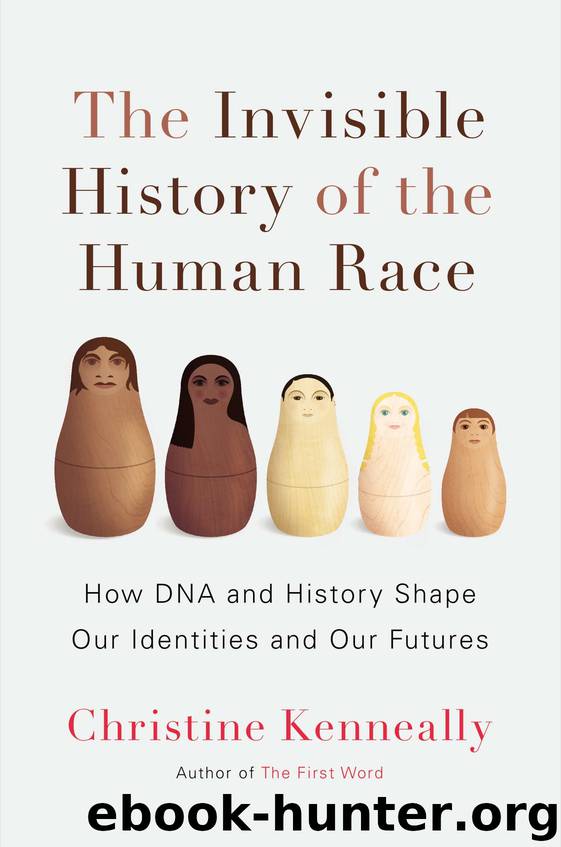The Invisible History of the Human Race by Christine Kenneally

Author:Christine Kenneally
Language: eng
Format: epub, mobi
Publisher: Penguin Group US
Published: 2014-09-24T16:00:00+00:00
Chapter 10
Chunks of DNA
Study the past if you would define the future.
—Confucius
On a winter’s night in Utah in 1999, Scott Woodward’s phone rang at 2:00 a.m. The father of four teenage sons, Woodward leaped to answer it and heard an older man at the other end ask, “Is this Scott Woodward?” Then, “Do you know anything about DNA?” Woodward was, in fact, a professor of molecular genetics at Brigham Young University. The caller said his name was James LeVoy Sorenson. He was from Utah but had traveled to Norway in search of his ancestral origins; he was trying to find a connection to the past, but he wasn’t getting very far. Sorenson wanted to know whether Woodward would be able to analyze the DNA of every individual in Norway for him. And if he could, how much would it cost?
Woodward, a pretty laid-back guy, said he’d think about it and he agreed to call Sorenson in a few weeks. He went back to his lab, and he hunted down some people who had worked for Sorenson. “Is this guy for real?” he asked. “Well, he’s been known to do crazier things,” was the reply. Indeed Sorenson was the richest man in Utah and one of the richest men in the world. He’d founded thirty-two different companies, personally held sixty patents, and in his lifetime had made well over a billion dollars. The consensus seemed to be that Sorenson’s projects tended to involve big ideas that cost a lot of money—and sometimes made a lot of money in return. One of these ideas was the disposable surgical mask, which Sorenson invented in the 1950s.
So Woodward thought about it. How much would it cost to analyze the DNA of everyone in Norway? How many people lived in the country? How could he obtain a blood sample from each one of them, and how much actual blood would that be? These were compelling questions, but Woodward wasn’t entirely comfortable with them. It was one thing to spend millions of dollars analyzing the DNA of an entire country, but it was another to determine if it was a worthwhile exercise. Would taking all that time and employing all those people be the best use of Sorenson’s money? Did the project have merit as well as ambition?
Of course, all professional scientists have to be budget conscious, as there’s only so much research funding to go around, and in order to get any of it, they have to show they can do more with it than the next lab jockey. But even if scientists weren’t competing for financial resources, they would—by nature—be cautious with them. The essence of all successful research involves wringing the most knowledge from the fewest experiments, and Woodward wasn’t clear about how much knowledge was enough to justify an undertaking of the scope of Sorenson’s proposal.
At the same time that he began putting together an estimate for the Norway project, Woodward started working on a second idea to propose to Sorenson. Woodward’s
Download
The Invisible History of the Human Race by Christine Kenneally.mobi
This site does not store any files on its server. We only index and link to content provided by other sites. Please contact the content providers to delete copyright contents if any and email us, we'll remove relevant links or contents immediately.
| Anatomy | Animals |
| Bacteriology | Biochemistry |
| Bioelectricity | Bioinformatics |
| Biology | Biophysics |
| Biotechnology | Botany |
| Ecology | Genetics |
| Paleontology | Plants |
| Taxonomic Classification | Zoology |
Sapiens: A Brief History of Humankind by Yuval Noah Harari(14242)
The Tidewater Tales by John Barth(12608)
Mastermind: How to Think Like Sherlock Holmes by Maria Konnikova(7221)
Do No Harm Stories of Life, Death and Brain Surgery by Henry Marsh(6887)
The Thirst by Nesbo Jo(6825)
Why We Sleep: Unlocking the Power of Sleep and Dreams by Matthew Walker(6618)
Life 3.0: Being Human in the Age of Artificial Intelligence by Tegmark Max(5472)
Sapiens by Yuval Noah Harari(5293)
The Longevity Diet by Valter Longo(5017)
The Body: A Guide for Occupants by Bill Bryson(4973)
The Rules Do Not Apply by Ariel Levy(4842)
The Immortal Life of Henrietta Lacks by Rebecca Skloot(4522)
Animal Frequency by Melissa Alvarez(4394)
Why We Sleep by Matthew Walker(4358)
The Hacking of the American Mind by Robert H. Lustig(4318)
Yoga Anatomy by Kaminoff Leslie(4303)
All Creatures Great and Small by James Herriot(4228)
Double Down (Diary of a Wimpy Kid Book 11) by Jeff Kinney(4204)
Barron's AP Biology by Goldberg M.S. Deborah T(4095)
